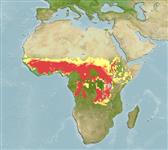Classification / Names
Common names from other countries
Main reference
Size / Weight / Age
Max length : 70.0 cm SL male/unsexed; (Ref. 4967)
Length at first maturity
Lm ?, range 39 - ? cm
Environment
Freshwater; demersal; pH range: 6.5 - 7.8; dH range: ? - 28; potamodromous (Ref. 51243)
Climate / Range
Tropical; 21°C - 25°C (Ref. 2060), preferred ?
Distribution
Africa: present in most rivers of West Africa, Lake Chad, the entire Congo River system, the Nile, East African lakes, and the rivers Omo and Giuba.
Countries | FAO areas | Ecosystems | Occurrences | Introductions
Short description
Dorsal
spines
(total): 2;
Dorsal
soft rays
(total): 7-8;
Anal
spines: 3-4;
Anal
soft rays: 6 - 8. Diagnosis: head width usually less than 2/3 of standard length, snout length more than 0.9 times the head width in adults (less in juveniles); hind margin of adipose fin rounded; premaxillary dentition forming (in adults) two close-set oval plates; maxillary barbel often blackish and only rarely reaching to anterior margin of opercule; 8-12 (usually 10 or 11) gill rakers on lower limb of first gill arch; palatine membrane with multiple invaginations, 1-4 of them forming longer lobes; dorsal margin of cleithral process ending in a point (visible only in adults)(Ref. 57126).
IUCN Red List Status (Ref. 115185)
Threat to humans
Harmless
Human uses
Fisheries: commercial
More information
ReferencesAquacultureAquaculture profileStrainsGeneticsAllele frequenciesHeritabilityDiseasesProcessingMass conversion
Tools
Special reports
Download XML
Internet sources
Estimates of some properties based on models
Phylogenetic diversity index
PD50 = 0.7500 many relatives (e.g. carps) 0.5 - 2.0 few relatives (e.g. lungfishes)
Trophic Level
2.9 ±0.33 se; Based on food items.
Resilience
Medium, minimum population doubling time 1.4 - 4.4 years (K=0.3)
Vulnerability
Moderate vulnerability (38 of 100)
Price category
